In today’s corporate landscape, prioritizing sustainability has become a paramount concern for business leaders. Effectively addressing the pressing issue of climate change demands precise and reliable carbon accounting. Currently, this process heavily relies on traditional spreadsheets and semi-automated tools, which unfortunately offer only a restricted view of emissions.
To revolutionize this approach, SAP is introducing cutting-edge solutions through its Environmental, Health, and Safety (EHS) Solution. At the forefront of this innovation is the Climate 21 initiative, which underscores SAP’s commitment to tackling climate-related challenges head-on. This initiative seeks to reshape the way carbon accounting is carried out. Through the integration of SAP EHS Solution and the visionary Climate 21 initiative, businesses can now engage in transactional carbon accounting that sets new standards for accuracy and precision. This entails capturing emissions data in a more granular and comprehensive manner, spanning the entirety of their operational activities and supply chains.
The main parts of this big effort include using SAP’s advanced technology to keep better track of carbon emissions. This helps companies not only take charge of their impact on the environment but also make choices based on data to lower their carbon footprint. To help with this change, SAP consulting companies has a really important role.
Product Capabilities
SAP Sustainability Footprint Management marks the initial stride in progressing from averages to real-time data, advancing into transactional carbon accounting. It furnishes a comprehensive overview of your carbon impact and empowers you to Capture, Document, and Take action in driving decarbonization across your value chain. These computations seamlessly incorporate supplier data and existing ERP business information, resulting in a substantial enhancement in the swiftness, precision, and effectiveness of emissions computation and control.
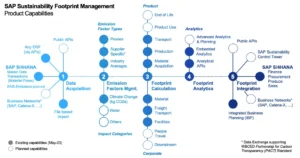
Source: https://blogs.sap.com/
Data Acquisition
The data acquisition process within SAP Sustainability Footprint Management presents a range of avenues for leveraging ERP data effectively. This encompasses both essential master data and dynamic transactional activity data, such as material movements. Seamlessly harmonizing with SAP S/4HANA Cloud and SAP S/4HANA (from 2021 onward) right from the start, this integration eliminates complexities. Moreover, for alternative ERP systems, a direct link can be established through Public APIs, bolstered by the comprehensive assistance of SAP services.
In parallel, a dedicated IT initiative becomes instrumental for this seamless amalgamation, fortified by the expert guidance available through SAP Services. An added dimension to data inclusion lies in the option of importing data via structured flat-file uploads, executed with utmost precision using customizable templates. Notably, the infusion of freight-transport specific master data components, including crucial entities like plant or supplier locations, is achieved fluidly through the mechanism of file upload.
In the future, we will improve how SAP S/4HANA works with other systems. This includes making sure product cost estimates are copied accurately for measuring environmental impact, and using existing data for figuring out transportation costs. We’ll also connect with SAP EHS Environment Management to help calculate greenhouse gas emissions. Additionally, we’ll link up with Business Networks like SAP Ariba and Catena-X to gather and exchange data following the PACT-Standard.
Emission Factors Management
After importing business data from your Enterprise Resource Planning (ERP) system, SAP’s Sustainability Footprint Management facilitates the assessment of the environmental repercussions of this data by importing and managing emission factors. The current emphasis is on gauging the climate change impact, specifically through Global Warming Potential (GWP) presented in CO2-equivalents (CO2e). The intention is to subsequently expand this scope to encompass other impact categories, such as water consumption or land utilization.
Emission factors can be seamlessly integrated into the system through Excel files, either from primary sources which directly represent data from your suppliers, or from secondary sources such as databases for Life Cycle Assessments (LCA), which offer industry-wide averages. In collaboration with Ecoinvent and Carbon Minds, SAP has established partnerships that provide access to LCA content via the SAP Store. This simplifies the process of importing data into the application. Moreover, you have the flexibility to incorporate customized data derived from your operations or LCA software tools, or alternatively employ estimated proxies for specific materials or activities.
To facilitate the transition from average to precise footprint calculations, there are plans underway to introduce an Application Programming Interface (API) for the exchange of product footprints across the value chain. This API will adhere to globally recognized standards such as the World Business Council for Sustainable Development’s Partnership for Carbon Transparency (WBCSD PACT) and the Together for Sustainability (TfS) initiative. By enabling direct access to supplier footprints, this initiative aims to simplify the mapping process and enhance data quality through the utilization of primary data.
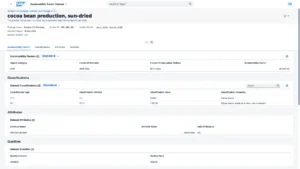
Source: https://blogs.sap.com/
Footprint Calculation
Our objective for SAP Sustainability Footprint Management is to encompass the complete lifecycle of products, spanning from creation to disposal. In the current version, we already encompass the initial phases up to the production stage, which incorporates emissions from obtaining and preparing materials, along with transportation, as well as the emissions directly generated by our production processes. Our future plans involve the inclusion of emissions from the later stages of a product’s life, specifically during its use and eventual disposal.
In terms of our overall environmental impact, we currently address the relevant GHG Scope 1, 2, and 3 categories, encompassing material sourcing, freight transportation, and facility-related emissions. We have intentions to expand our coverage to include additional Scope 3 categories associated with downstream emissions and personal transportation in upcoming releases.
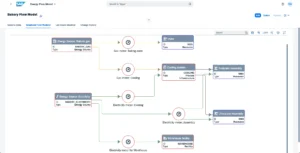
Source: https://blogs.sap.com/
Footprint Analytics
SAP Sustainability Footprint Management provides integrated analytical tools to examine calculated footprints and extract novel insights. Through a range of interactive dashboards, you have the capability to scrutinize your corporate environmental impact comprehensively, encompassing both emission inflows and outflows. Additionally, the platform facilitates an in-depth assessment of emissions associated with purchased and sold products, as well as energy consumption.
Furthermore, the analytics feature enables a granular exploration of emissions based on factors such as GHG scope, category, and energy source, enabling you to identify and comprehend patterns over time. When it comes to transport footprints, specialized dynamic dashboards are at your disposal, featuring extensively customizable charts and detailed reports encompassing various key performance indicators (KPIs) related to transportation.
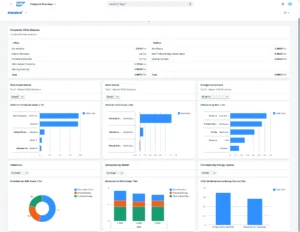
Source: https://blogs.sap.com/
Footprint Integration
Finally, a crucial and noteworthy aspect is the seamless integration of the calculated environmental footprints into the entirety of business operations, offering a transparent view and valuable insights into sustainability metrics. This integration is not limited to sustainability experts within dedicated departments but extends to all members of the company, across different lines of business. The data derived from SAP Sustainability Footprint Management can be effortlessly incorporated into the connected SAP S/4HANA Cloud or SAP S/4HANA systems, ensuring accessibility and usability for users at various levels. This accessibility empowers them to factor in these sustainability criteria when making informed decisions.
To facilitate the integration of footprints into business processes, the Key User Extensibility feature can be utilized. Looking ahead, there are plans to further enhance this integration by embedding footprints directly into more SAP S/4HANA applications and processes. Initial instances of this integration are already in place, such as the inclusion of product footprints in Purchase Requisitions within the Purchasing domain. This allows both approvers and operational purchasers to evaluate the environmental impact associated with their requisitions.
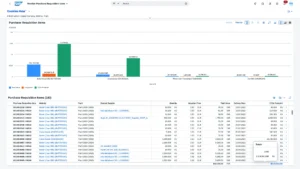
Source: https://blogs.sap.com/
Business Architecture
SAP Sustainability Footprint Management stands as a cloud-based application intricately woven into the fabric of the SAP Business Technology Platform. Within this platform, the application’s functionality encompasses the orchestration of data imports, channeling them to invoke the Data Extractor housed within the Sustainability Integration Component rooted in ABAP.
Alternatively, a pathway enabled by APIs allows the harnessing of data importation from varied sources, be it ECC or other ERP systems. Furthermore, the versatility of data import is extended through file uploads. Notably, the importation of Emission Factors from proprietary or third-party databases is also facilitated through the avenue of file uploads.
In the continuum of progress, our vision encompasses a deeper integration with SAP S/4HANA EHS Environment Management in forthcoming iterations. This will empower the utilization of GHG Scope 1 & 2 emissions data, along with waste data. A parallel endeavor involves integration with Business Networks and SAP Sustainability Data Exchange, which will effectively serve as conduits for the acquisition of primary and real-time footprint data directly from suppliers.
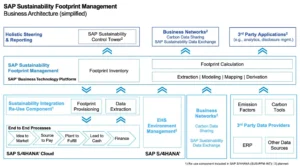
Source: https://blogs.sap.com/
Conclusion
In the ever-evolving landscape of corporate responsibility, SAP Sustainability Footprint Management emerges as a beacon of innovation, redefining the way businesses approach carbon accounting and environmental impact assessment. With the strategic fusion of SAP’s cutting-edge technology, the Environmental, Health, and Safety (EHS) Solution, and the visionary Climate 21 initiative, a new era of transactional carbon accounting is ushered.



